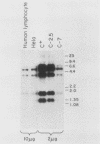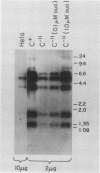Abstract
We have studied the mechanism of cellular resistance to cardiac glycosides in C+ cells. C+ cells were resistant to ouabain and overproduced plasma membrane-bound Na,K-ATPase relative to parental HeLa cells. Overexpression of Na,K-ATPase in C+ cells correlated with increased ATPase mRNA levels and amplification (approximately 100 times) of the ATPase gene. Growth of C+ cells in ouabain-free medium resulted in a marked decline in ATPase mRNA and DNA levels. However, when cells were reexposed to ouabain, they proliferated and ATPase mRNA and DNA sequences were reamplified. Restriction analysis of C+ and other human DNA samples revealed the occurrence of rearrangements in the region of the Na,K-ATPase gene in C+ cells. Furthermore, C+ cells expressed an ATPase mRNA species not found in HeLa cells. These results suggest that amplification of the gene coding for Na,K-ATPase results in overproduction of Na,K-ATPase polypeptides. Amplification of the ATPase gene or the expression of new ATPase mRNA sequences or both may also be responsible for acquisition of the ouabain-resistant phenotype.
Full text
PDF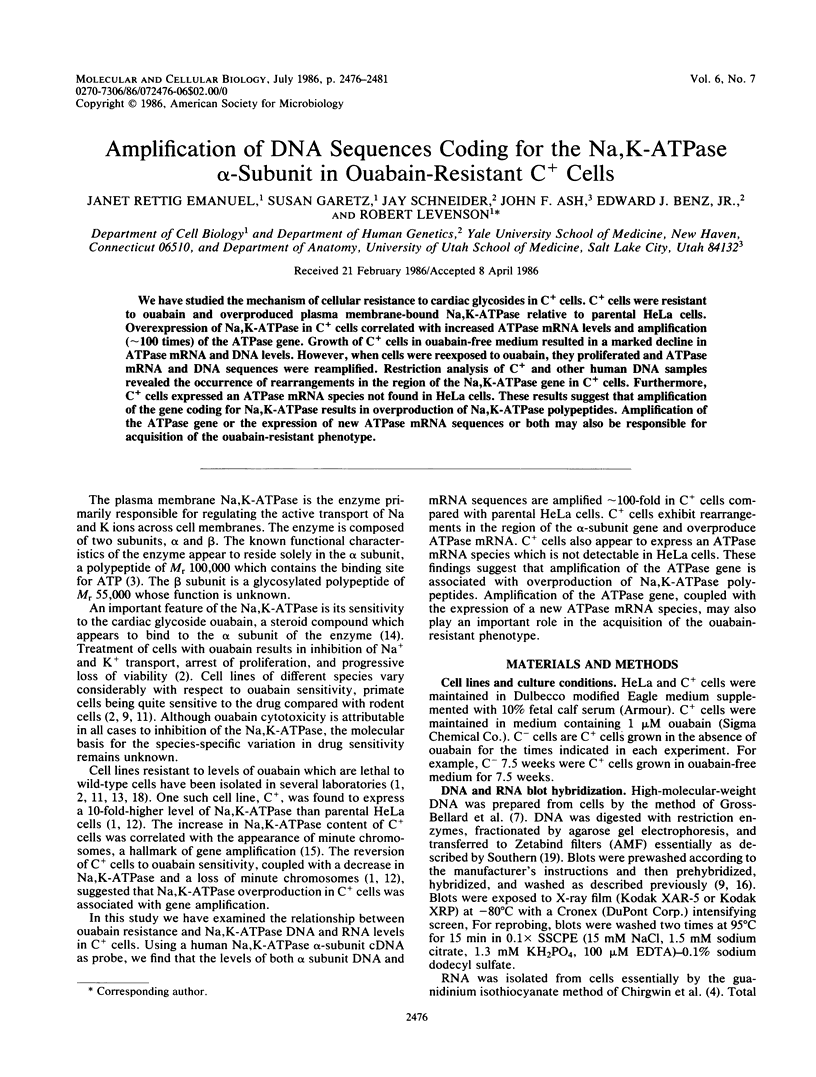
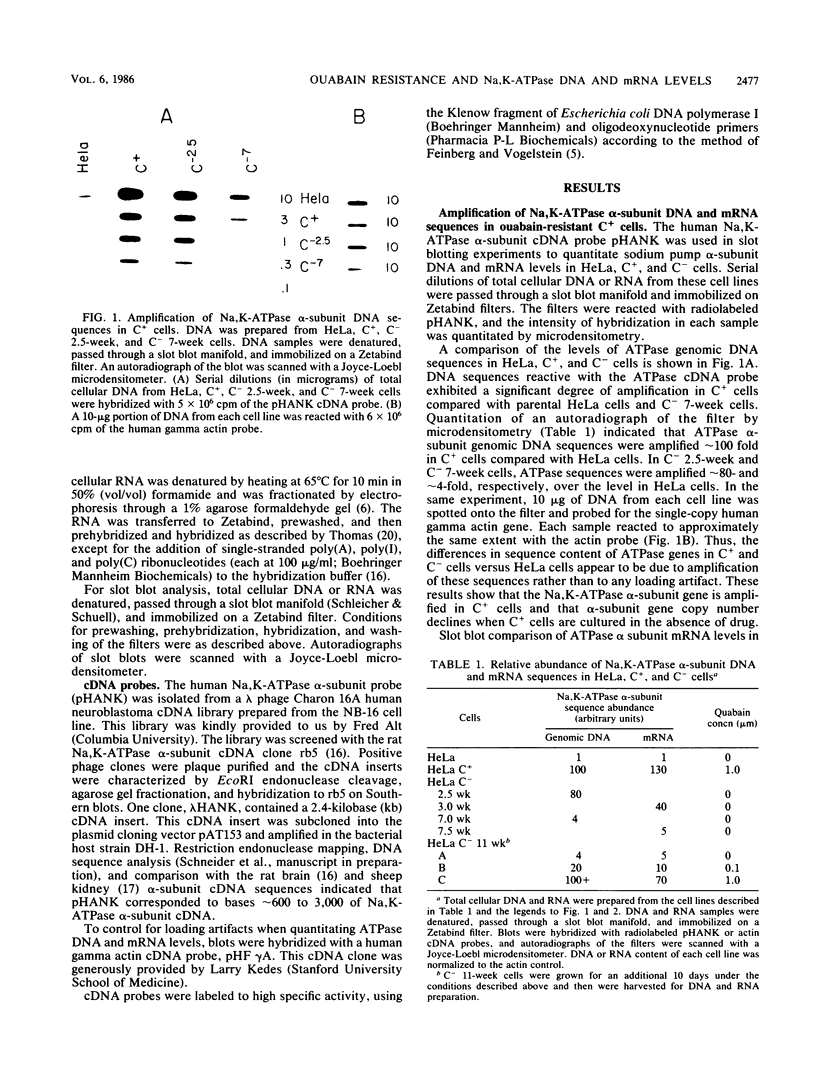
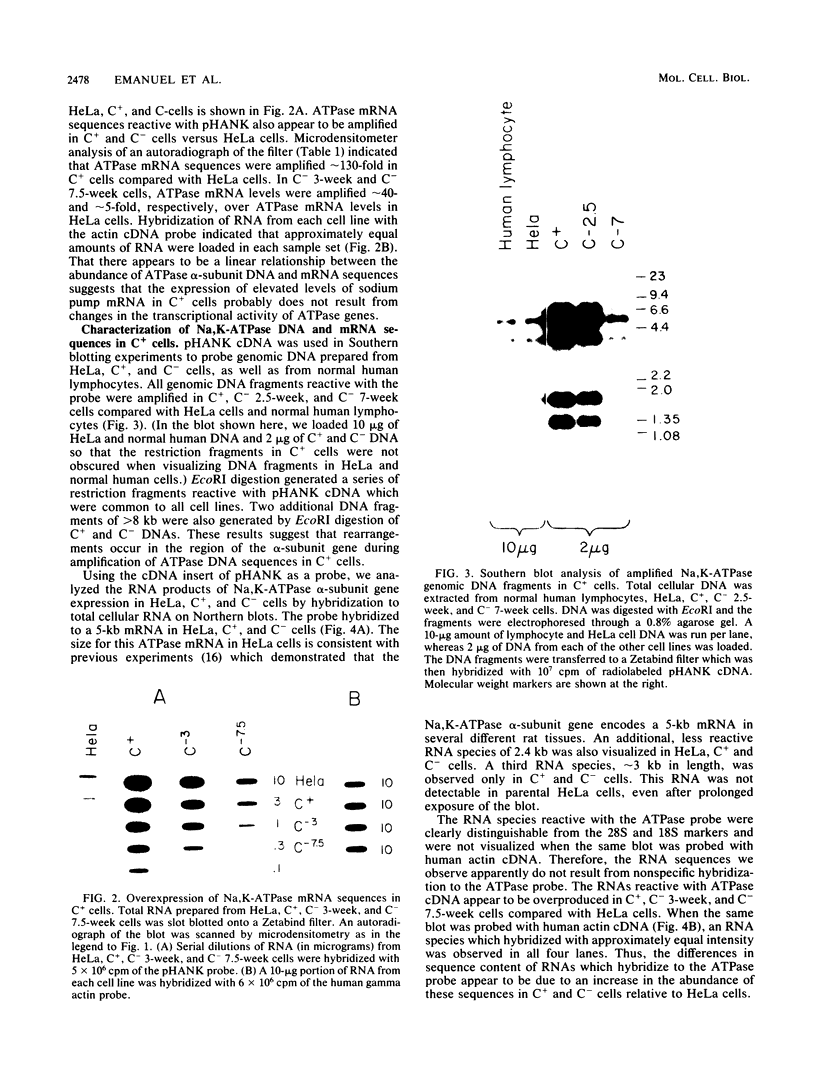
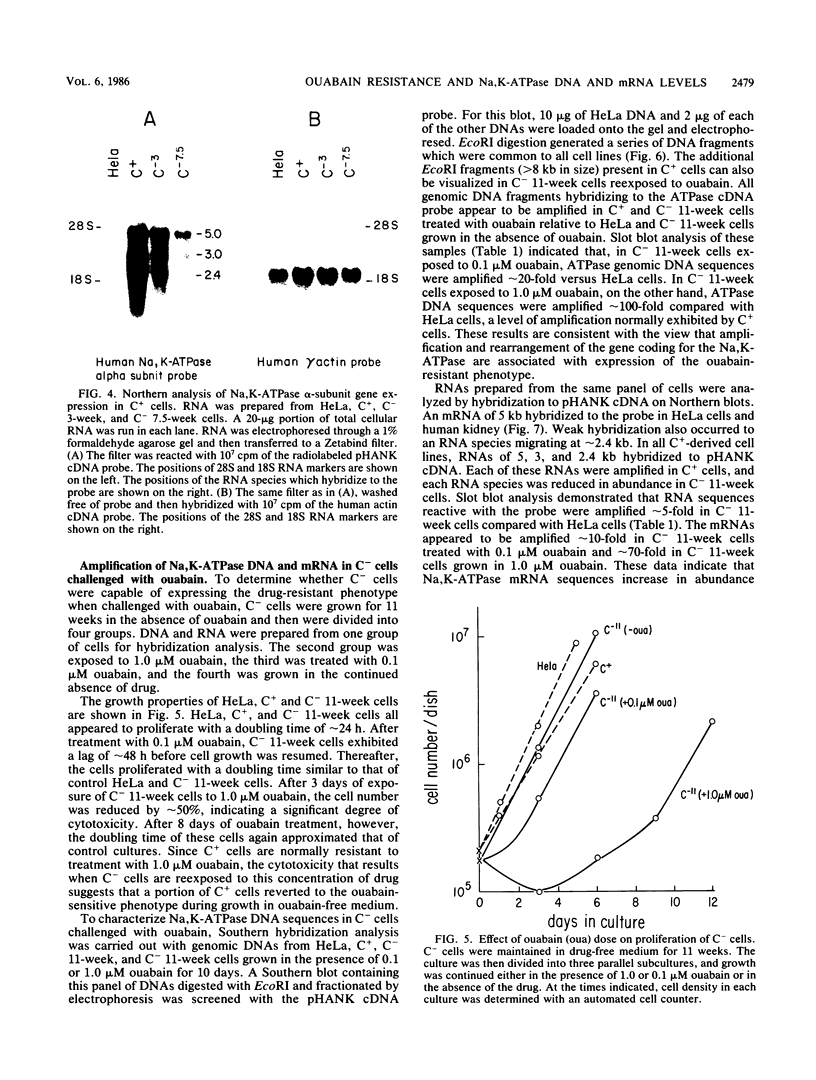
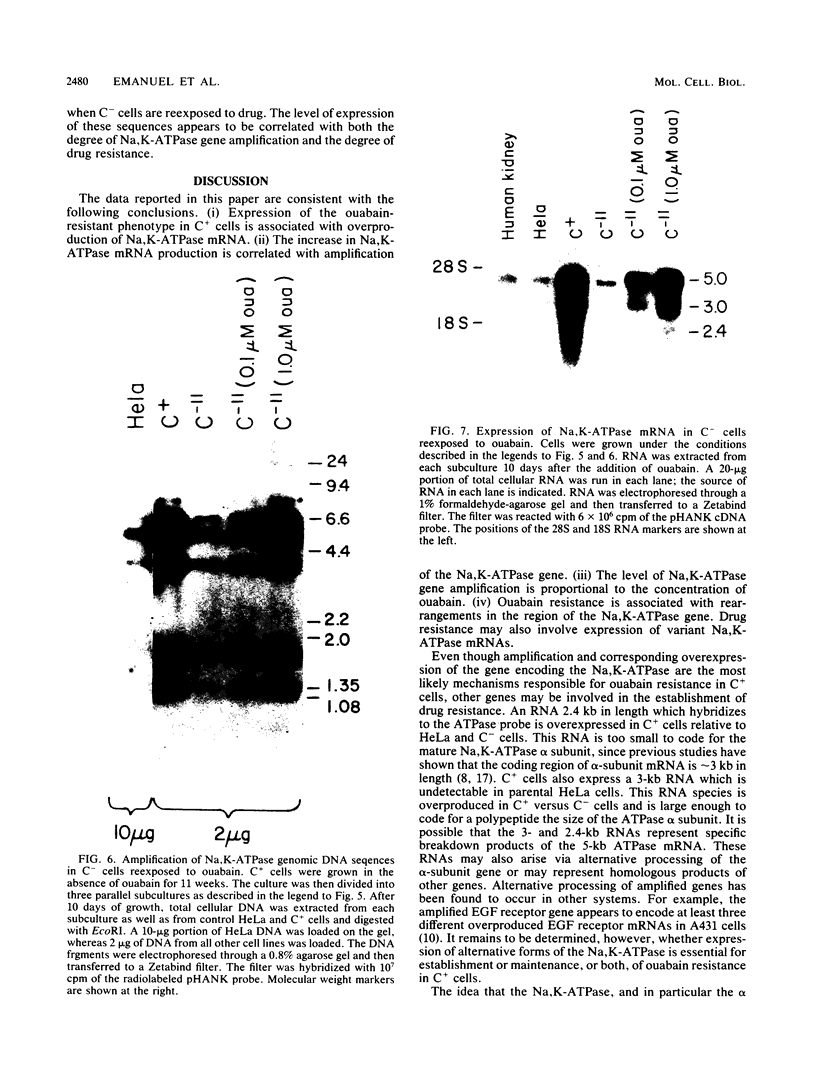
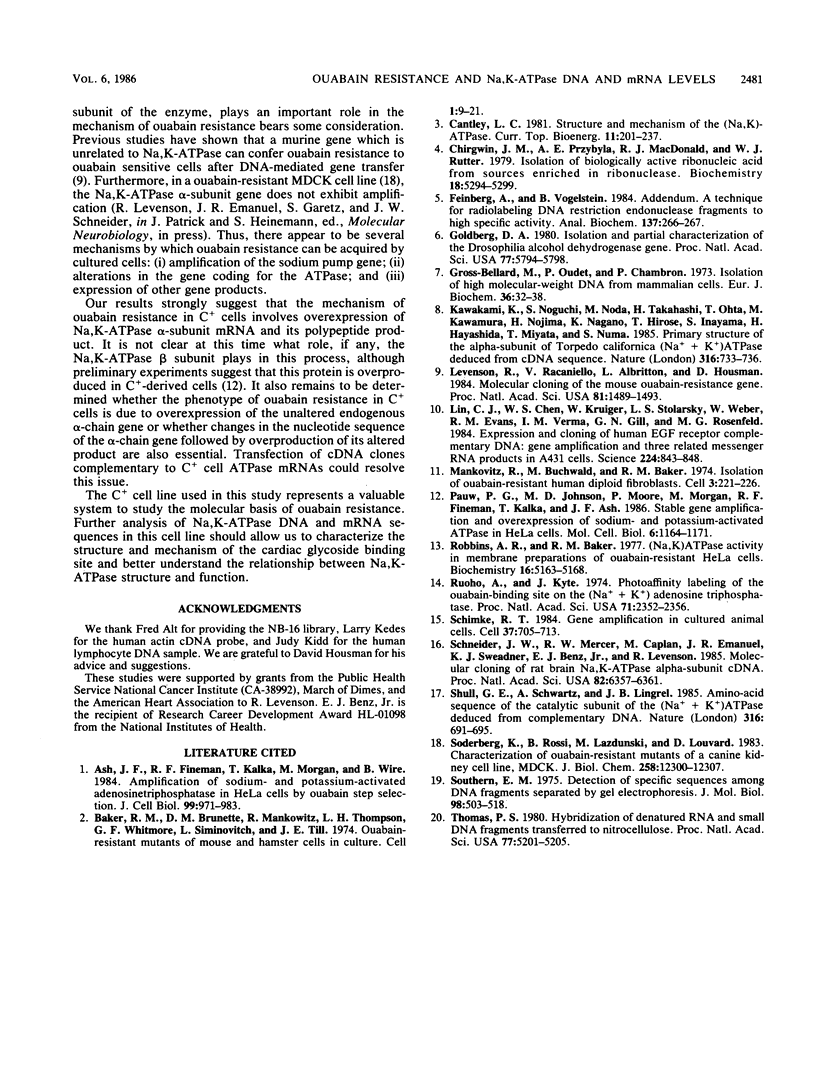
Images in this article
Selected References
These references are in PubMed. This may not be the complete list of references from this article.
- Ash J. F., Fineman R. M., Kalka T., Morgan M., Wire B. Amplification of sodium- and potassium-activated adenosinetriphosphatase in HeLa cells by ouabain step selection. J Cell Biol. 1984 Sep;99(3):971–983. doi: 10.1083/jcb.99.3.971. [DOI] [PMC free article] [PubMed] [Google Scholar]
- Chirgwin J. M., Przybyla A. E., MacDonald R. J., Rutter W. J. Isolation of biologically active ribonucleic acid from sources enriched in ribonuclease. Biochemistry. 1979 Nov 27;18(24):5294–5299. doi: 10.1021/bi00591a005. [DOI] [PubMed] [Google Scholar]
- Feinberg A. P., Vogelstein B. "A technique for radiolabeling DNA restriction endonuclease fragments to high specific activity". Addendum. Anal Biochem. 1984 Feb;137(1):266–267. doi: 10.1016/0003-2697(84)90381-6. [DOI] [PubMed] [Google Scholar]
- Goldberg D. A. Isolation and partial characterization of the Drosophila alcohol dehydrogenase gene. Proc Natl Acad Sci U S A. 1980 Oct;77(10):5794–5798. doi: 10.1073/pnas.77.10.5794. [DOI] [PMC free article] [PubMed] [Google Scholar]
- Gross-Bellard M., Oudet P., Chambon P. Isolation of high-molecular-weight DNA from mammalian cells. Eur J Biochem. 1973 Jul 2;36(1):32–38. doi: 10.1111/j.1432-1033.1973.tb02881.x. [DOI] [PubMed] [Google Scholar]
- Kawakami K., Noguchi S., Noda M., Takahashi H., Ohta T., Kawamura M., Nojima H., Nagano K., Hirose T., Inayama S. Primary structure of the alpha-subunit of Torpedo californica (Na+ + K+)ATPase deduced from cDNA sequence. Nature. 1985 Aug 22;316(6030):733–736. doi: 10.1038/316733a0. [DOI] [PubMed] [Google Scholar]
- Levenson R., Racaniello V., Albritton L., Housman D. Molecular cloning of the mouse ouabain-resistance gene. Proc Natl Acad Sci U S A. 1984 Mar;81(5):1489–1493. doi: 10.1073/pnas.81.5.1489. [DOI] [PMC free article] [PubMed] [Google Scholar]
- Lin C. R., Chen W. S., Kruiger W., Stolarsky L. S., Weber W., Evans R. M., Verma I. M., Gill G. N., Rosenfeld M. G. Expression cloning of human EGF receptor complementary DNA: gene amplification and three related messenger RNA products in A431 cells. Science. 1984 May 25;224(4651):843–848. doi: 10.1126/science.6326261. [DOI] [PubMed] [Google Scholar]
- Mankovitz R., Buchwald M., Baker R. M. Isolation of ouabain-resistant human diploid fibroblasts. Cell. 1974 Nov;3(3):221–226. doi: 10.1016/0092-8674(74)90135-4. [DOI] [PubMed] [Google Scholar]
- Pauw P. G., Johnson M. D., Moore P., Morgan M., Fineman R. M., Kalka T., Ash J. F. Stable gene amplification and overexpression of sodium- and potassium-activated ATPase in HeLa cells. Mol Cell Biol. 1986 Apr;6(4):1164–1171. doi: 10.1128/mcb.6.4.1164. [DOI] [PMC free article] [PubMed] [Google Scholar]
- Robbins A. R., Baker R. M. (Na, K)ATPase activity in membrane preparations of ouabain-resistant HeLa cells. Biochemistry. 1977 Nov 15;16(23):5163–5168. doi: 10.1021/bi00642a600. [DOI] [PubMed] [Google Scholar]
- Ruoho A., Kyte J. Photoaffinity labeling of the ouabain-binding site on (Na+ plus K+) adenosinetriphosphatase. Proc Natl Acad Sci U S A. 1974 Jun;71(6):2352–2356. doi: 10.1073/pnas.71.6.2352. [DOI] [PMC free article] [PubMed] [Google Scholar]
- Schimke R. T. Gene amplification in cultured animal cells. Cell. 1984 Jul;37(3):705–713. doi: 10.1016/0092-8674(84)90406-9. [DOI] [PubMed] [Google Scholar]
- Schneider J. W., Mercer R. W., Caplan M., Emanuel J. R., Sweadner K. J., Benz E. J., Jr, Levenson R. Molecular cloning of rat brain Na,K-ATPase alpha-subunit cDNA. Proc Natl Acad Sci U S A. 1985 Sep;82(18):6357–6361. doi: 10.1073/pnas.82.18.6357. [DOI] [PMC free article] [PubMed] [Google Scholar]
- Shull G. E., Schwartz A., Lingrel J. B. Amino-acid sequence of the catalytic subunit of the (Na+ + K+)ATPase deduced from a complementary DNA. Nature. 1985 Aug 22;316(6030):691–695. doi: 10.1038/316691a0. [DOI] [PubMed] [Google Scholar]
- Soderberg K., Rossi B., Lazdunski M., Louvard D. Characterization of ouabain-resistant mutants of a canine kidney cell line, MDCK. J Biol Chem. 1983 Oct 25;258(20):12300–12307. [PubMed] [Google Scholar]
- Southern E. M. Detection of specific sequences among DNA fragments separated by gel electrophoresis. J Mol Biol. 1975 Nov 5;98(3):503–517. doi: 10.1016/s0022-2836(75)80083-0. [DOI] [PubMed] [Google Scholar]
- Thomas P. S. Hybridization of denatured RNA and small DNA fragments transferred to nitrocellulose. Proc Natl Acad Sci U S A. 1980 Sep;77(9):5201–5205. doi: 10.1073/pnas.77.9.5201. [DOI] [PMC free article] [PubMed] [Google Scholar]




